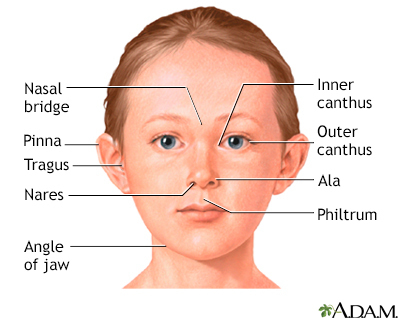Micrognathia
Definition
Micrognathia is a term for a lower jaw that is smaller than normal.
Considerations
In some cases, the jaw is small enough to interfere with the infant's feeding. Infants with this condition may need special nipples in order to feed properly.
Micrognathia often corrects itself during growth. The jaw may grow a lot during puberty. The problem can be caused by certain inherited disorders and syndromes.
Micrognathia can cause the teeth not to align properly. This can be seen in the way the teeth close. Often there will not be enough room for the teeth to grow.
Children with this problem should see an orthodontist when the adult teeth come in. Because children may outgrow the condition, it often makes sense to delay treatment until a child is older.
Causes
Micrognathia may be part of other genetic syndromes, including:
- Cri du chat syndrome
- Hallermann-Streiff syndrome
- Marfan syndrome
- Pierre Robin syndrome
- Progeria
- Russell-Silver syndrome
- Seckel syndrome
- Smith-Lemli-Opitz syndrome
- Treacher-Collins syndrome
- Trisomy 13
- Trisomy 18
- XO syndrome (Turner syndrome)
Home Care
You may need to use special feeding methods for a child with this condition. Most hospitals have programs where you can learn about these methods.
When to Contact a Medical Professional
Contact your health care provider if:
- Your child seems to have a very small jaw
- Your child has trouble feeding properly
What to Expect at Your Office Visit
The provider will do a physical exam and may ask questions about the problem. Some of these may include:
- When did you first notice that the jaw was small?
- How severe is it?
- Does the child have trouble eating?
- What other symptoms are present?
The physical exam will include a thorough check of the mouth.
The following tests may be performed:
Depending on the symptoms, a child may need to be tested for an inherited condition that may be the source of the problem. The child may need surgery or devices to correct tooth position.
Gallery

References
Enlow E, Greenberg JM. Clinical manifestations of diseases in the newborn. In: Kliegman RM, St. Geme JW, Schor NF, Blum NJ, Shah SS, et al, eds. Nelson Textbook of Pediatrics. 21st ed. Philadelphia, PA: Elsevier; 2020:chap 119.
Hartsfield JK, Morford LA. Acquired and developmental disturbances of the teeth and associated oral structures. In: Dean JA, ed. McDonald and Avery's Dentistry for the Child and Adolescent. 11th ed. Philadelphia, PA; 2022: chap 3.
Resnik R, Lockwood CJ, Moore TR, Greene MF, Copel JA, Silver RM. Imaging of the face and neck. In: Resnik R, Lockwood CJ, Moore TR, Greene MF, Copel JA, Silver RM, eds. Creasy and Resnik's Maternal-Fetal Medicine: Principles and Practice. 8th ed. Philadelphia, PA: Elsevier; 2019:chap 23.